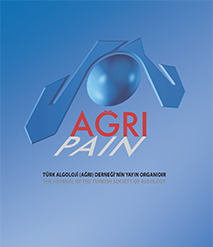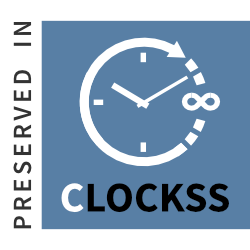Quick Search
Volume: 30 Issue: 3 - 2018
| REVIEW | |
| 1. | Patient satisfaction with nursing practices about postoperative pain management: A systematic review Fatma Eti Aslan, Sennur Kula Şahin, Selda Secginli, Semra Bülbüloğlu PMID: 30028476 doi: 10.5505/agri.2018.96720 Pages 105 - 115 Objectives: The aim of this study was to investigate patient satisfaction with nursing practices regarding postoperative pain management. Methods: A systematic review of the literature published between 2005 and 2015 was conducted, comprising a search of 7 databases: ScienceDirect, Turkish Medline, PsycINFO, Ovid, Prequest, Google Scholar, and the ULAKBIM Turkish Medical Database. Five articles were identified as eligible for review. The methodological quality of the studies was assessed using the Turkish version of the Joanna Briggs Institute-Meta Analysis of Statistics Assessment and Review Instrument (JBI -MAStARI) Critical Appraisal Checklist. The data were extracted using a standard data extraction form developed for this study, and subsequently evaluated. Results: In the articles eligible for this review, the study samples comprised patients with blunt or penetrating trauma sent to the emergency room (n=418) and those who underwent total knee replacement (n=120); heart, lung, or gastrointestinal system surgery (n=559); or open heart surgery (n=52). The maximum pain score was 7.20±1.95 (min-max: 0-10) and the maximum satisfaction score was 100%. The findings revealed that pharmacological methods were most frequently used for postoperative pain management and non-pharmacological methods were not used sufficiently by nurses. Nevertheless, the patients were satisfied with the postoperative pain relief nursing care. Conclusion: In this systematic review, scientific evidence indicated that patient satisfaction with nursing practices related to postoperative pain management was high; however, non-pharmacological methods were used insufficiently in the last decade. |
| EXPERIMENTAL AND CLINICAL STUDIES | |
| 2. | Effect of applying reflexology massage on nitroglycerin-induced migraine-type headache: A placebo-controlled clinical trial Nima Imani, Shams Aldin Shams, Moloud Radfar, Haleh Ghavami, Hamid Reza Khalkhali PMID: 30028477 doi: 10.5505/agri.2018.43815 Pages 116 - 122 Objectives: Nitroglycerin (NTG)-induced migraine-type headache is the most prominent side effect of nitrate therapy. Therefore, the aim of this study was to clarify the effectiveness of reflexology massage on intravenous NTG-induced headache in coronary care unit (CCU) inpatients. Methods: This was a randomized clinical trial. The study sample included 75 patients that were randomly divided into three groups: control, intervention, and placebo groups. The intensity of baseline headache in patients who received NTG was measured by the numeric rating scale for pain (NRS Pain). Patients in the intervention group received reflexology massage two times for 20 min (at 3-h interval), wherein the upper part of patient’s both foot thumbs, which is the reflection point of the head, was massaged. In the placebo group, an unspecified point on the foot (heel), which was not related to the head, was massaged. Patients in the control group did not receive any massage. Results: No baseline differences existed among the three groups for the mean pain scale score (p=0.66) before the study; but the difference between the groups after the application was statistically significant (p=0.000). Conclusion: Reflexology massage can reduce the intensity of NTG-induced headache. |
| 3. | Evaluation of the effects of subcostal transversus abdominis plane block on acute and subacute pain development following inguinal herniography: Randomized clinical study Çiğdem Akyol Beyoğlu, Aylin Özdilek, Emre Erbabacan, Elif Aybike Özmumcu, Birsel Ekici, Güniz Köksal, Fatiş Altıntaş, Sevim Purisa PMID: 30028478 doi: 10.5505/agri.2018.49344 Pages 123 - 129 Objectives: The effect of subcostal transversus abdominis plane (TAP) block on postoperative pain is contradictive. The aim of this study was to evaluate the effect of subcostal TAP block on subacute pain in patients who have undergone inguinal herniography. Methods: Patients aged between 18 and 75 years with American Society of Anesthesiologists 1–3 and who were to undergo elective unilateral inguinal herniography with mesh under general anesthesia were included. Fifty patients were under an intravenous analgesic regimen (group I) and 50 patients underwent subcostal TAP block postoperatively in addition to the intravenous analgesic regimen (group II). The primary outcome measure was pain scores 1 month postoperatively by comparing Numerical Rating Scale values with the Mann–Whitney U test between groups I and II. Secondary outcome measures were life qualification scores 1 month postoperatively and pain scores 24 h and 15 days postoperatively. Results: Postoperative 15th-min; 1st-, 6th-, 12th-, and 24th-h; 15th-day (p=0.00); and 1st-month Numerical Rating Scale values were significantly lower in group II than in group I (p=0.02). No significant difference was observed between the groups in terms of LQS 15 days postoperatively (p=0.013). On group comparison, LQS was higher in the 1st month than at the 15th day postoperatively in group I (p=0.201). Conclusion: Subcostal TAP block provides an effective postoperative pain treatment in the acute period and in the 1st postoperative month in patients undergoing inguinal herniography. |
| 4. | Effect of proprioceptive training on balance in patients with chronic neck pain Mehmet Duray, Şule Şimşek, Filiz Altuğ, Uğur Cavlak PMID: 30028479 doi: 10.5505/agri.2018.61214 Pages 130 - 137 Objectives: The aim of this randomized controlled study was to investigate the effect of proprioceptive training on balance in patients with chronic neck pain (CNP). Methods: Forty patients participating in the study were randomly divided into study and control groups. Both of the groups underwent conventional physical therapy; additionally, the study group was rehabilitated with gaze direction recognition exercise (GDRE) for proprioceptive training. Exercises were performed during 3 weeks with five sessions per week. Pain intensity [visual analog scale (VAS)], neck disability [Neck Disability Index (NDI)], and balance [four step square test (FSST), single leg balance test (SLBT) with eyes opened and closed] assessments were conducted in the patients before and after the treatment and 3 weeks after the last session. Results: No differences were observed between the groups in terms of pre-treatment measurements. There was a statistically significant decrease in VAS scores in both groups compared with pre-treatment conditions (p<0.05). In addition, whereas a statistically significant improvement in the study group’s NDI, FSST, and SLBT with eyes opened and closed scores was observed after the treatment, pre- and post-treatment results were similar in the control group (p>0.05). Conclusion: Proprioceptive training should be included in physiotherapy programs to improve balance; it decreases the disability level in patients with CNP. |
| CASE REPORTS | |
| 5. | Laparoscopic gastrostomy under awake thoracic epidural anesthesia: A successful experience Ömer Karaca, Hüseyin Ulaş Pınar, Enes Duman, Rafi Doğan PMID: 30028480 doi: 10.5505/agri.2017.49091 Pages 138 - 141 General anesthesia is the first choice as an anesthesia method particularly for abdominal operations. However, because neuromuscular blockade induced during general anesthesia will increase atelectasis in a patient with pulmonary disease, it will also increase postoperative ventilator dependence, which will be even more apparent in cases of chronic obstructive pulmonary disease (COPD) that pose a risk, particularly for postoperative complications. Herein, thoracic epidural anesthesia (TEA) was found to be a better option for our patient with severe COPD and stage IV lung cancer, as it provided sufficient anesthesia and better postoperative care for laparoscopic gastrostomy. |
| 6. | Idiopathic intracranial hypertension without headache: A case report and literature review Yasemin Eren, Naciye Kabataş, Neşe Güngör Yavaşoğlu, Selim Selçuk Çomoğlu PMID: 30028481 doi: 10.5505/agri.2017.70370 Pages 142 - 145 This study reports the case of a 23-year-old man with idiopathic intracranial hypertension (IIH) who presented with blurred vision and diplopia, without accompanying headache. Although headache is the most common symptom associated with IIH, occasionally, it may not be observed clinically. This situation is more frequently observed in males, young adults, children, and in patients with low body mass index. This case highlights a crucial aspect; patients who present with serious visual symptoms without headache must be treated aggressively because vision loss will develop rapidly. |
| 7. | Unruptured aneurysm producing thunderclap headache treated with endovascular coil embolization Pınar Gelener, Süha Halil Akpınar PMID: 30028482 doi: 10.5505/agri.2017.78045 Pages 146 - 149 The abrupt onset of acute, high-intensity headache, unlike any experienced before, can be an urgent medical condition, which requires attention. A 32-year-old female patient developed thunderclap headache attacks had applied with increasing intensity and frequency since 1 week. She had visited the emergency department several times, and cranial computed tomography findings were normal. On the last presentation, neurological examination showed complete oculomotor nerve palsy on the left. Brain magnetic resonance imaging together with intracranial brain angiography revealed left posterior communicating aneurysm compressing the ipsilateral oculomotor nerve, with no evidence of subarachnoid hemorrhage. The patient was treated with endovascular balloon-assisted coil embolization of the aneurysm under digital subtraction angiography. As a result, the headache resolved soon after the intervention. Furthermore, complete ptosis recovered by the third month. Although thunderclap headache has rarely been attributed to an enlarging unruptured cerebral aneurysm, early recognition and treatment are rather important as it may indicate a high risk of rupture. |
| LETTER TO THE EDITOR | |
| 8. | Ultrasound-guided distal adductor canal catheter placement for continuous postoperative analgesia in lower leg surgery Onur Balaban, Tayfun Aydın, Lokman Demir PMID: 30028483 doi: 10.5505/agri.2018.54037 Pages 150 - 151 Abstract | |





